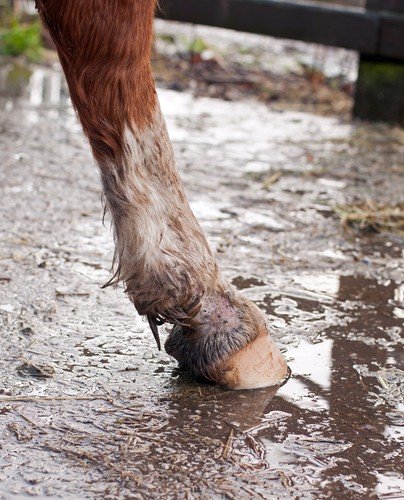We all know that horses hold a place of honor in many cultures. For the same reason, the relationship between humans and horses has always been unique. Horses are our companions and have been benefiting us for long. Yes, for instance, they hauled goods, plowed fields, served as a means of transport and source of recreation. They served humans in battles and also participated in games along with humans. On the other hand, one thing that can startle a horse keeper is Desmitis. And just like any other living being, horses require as much love, care, and support. However, Desmitis in horses is one of the greatest concerns.
Desmitis is the inflammation of a ligament. It causes varying degrees of lameness in horses. In case you are wondering what the ligament is, a ligament is a fibrous connective tissue that connects bones to bones. Now you can imagine what could happen if a ligament gets damaged.
Symptoms of Desmitis
- Generalized limping
- Behavior changes
- Swelling
- Reluctance to stand
- Poor performance
- Heat at the site of damage or swelling
- Inability to put weight on the limb
Well, many factors can cause Desmitis in horses such as poor conformation, shoeing problems, and jumping and racing as jumping and racing put additional strain on the ligament of the leg. Consequently, horses become more prone to damage to suspensory ligaments.
Degenerative suspensory ligament Desmitis (DSLD)
As far as Degenerative suspensory ligament Desmitis (DSLD) is concerned, it is a systemic disease of ligaments/connective tissues of horses. Therefore, many horse breeds suffer from DSLD. Along with horses, it also occurs in crossbreeds and mules.
Since degenerative suspensory ligament Desmitis is a debilitating disease, hence, it leads to persistent and incurable lameness. Causes of DSLD are:
- Overwork and old age.
- The disease is also hereditary because it affects horses of all ages, including foals.
- Abnormal accumulation of substances called proteoglycans between fibers of affected tissues, also cause DSLD. Proteoglycans are a sugar-protein complex normally present between cells, which provides structural support. We all know that excess, beyond a normal range, is not good.
- In healthy horses, the ligaments can tolerate tiny stress and strains. Moreover, the collagen in the ligaments repairs these minor injuries. Whereas, if a horse is affected by DSLD, the abnormal healing response occurs. As a result of failure to manufacture new collagen, this abnormal healing response occurs. Thus, losing the elasticity and strength results in enlargement and hardening of ligaments. It makes ligament prone to several injuries.
As mentioned earlier, DSLD is a systemic disorder; it is not limited to the suspensory ligament. In addition to that, Desmitis in horses also affects tissues in eyes, skin, aorta, lungs, and other organs. DSLD is diagnosed by physical and clinical signs, history, and imaging.
Symptoms of DSLD
- Both front or hind limb lameness
- Painful response to examination
- Hardening and enlargement of the suspensory ligament
- Swelling and sinking of the fetlock
- Fetlock appearing closer to the ground
- Pastern appear closer to horizontal
- Stifle and hock appear straightened
When these symptoms appear, it is better to have your horse examined by a veteran.
Treatment for DSLD
DSLD is a degenerative disease, which means that the affected horse will not be able to recover fully and regain its previous athletic ability.
Unfortunately, what you can do to DSLD is to alleviate the pain and make the horse able to survive and be comfortable. Hence, intense observation and management are necessary. Treatment involves:
- Proper stall flooring. Use sand for stall floors. It is non-slip and, therefore, is easy on the horse’s legs.
- Shoeing techniques used to raise horse heels
- Supportive leg wraps
- Stall confinement for six months to one year along with pain medication
- Methyl Sulfonyl Methane (MSM) supplements help restore tissue flexibility.
However, there are varying degrees of degenerative suspensory ligament Desmitis. If your horse is suffering from DSLD, it doesn’t mean that there is no hope for it to live a healthy life. In other words, supportive care, exercise restrictions, and shoeing changes manage DSLD.
Suspensory Desmitis in Horses
However, before jumping right into the disease, let us first talk about the main elements discussed here, the suspensory ligament.
The suspensory ligament is a connective tissue attached to the knee (in the front legs) or hock (in the hind legs) and the upper cannon bone. It goes the cannon bone downwards and divides into two branches. Furthermore, the suspensory ligament is divided into three regions. Suspensory Desmitis can occur in any of these three regions:
- Proximal suspensory ligament Desmitis (proximal, the upper part).
- Midbody suspensory ligament Desmitis.
- Branch suspensory ligament Desmitis
Proximal suspensory ligament Desmitis
It can occur in both forelimb and hind limbs. However, in the forelimb, there is usually acute onset lameness. Whereas, in hind limbs, the disease is chronic and progressive. It is common in all types of athletic horses. It is called proximal because it is limited to the proximal one-third part of the limb. Generally, the symptoms of proximal suspensory ligament Desmitis include:
- Loss of action and implosion.
- Poor specific dressage movements.
- Poor performance.
- Lameness after strenuous exercise.
Single overloading injury or repetitive strain causes proximal suspensory ligament Desmitis. Lameness varies from mild to moderate but becomes severe as a result of significant involvement of ligament and its attachment. It is diagnosed through nerve blocks, ultrasound scans, and bone scans. Recent injuries have a better capacity to heal fully because these are less severe. Therefore, it is better to diagnose early. Diagnosis, firstly, depends on localizing the pain. However, there can be no localizing signs such as swelling, pain, or heat. Nerve blocks are used to localize pain. Once the pain is localized, other imaging techniques are used.
Because changes can be subtle, high-quality imaging is essential. Ultrasound serves this purpose. The ultrasound is then compared to the opposite limb. It is also important to rule out whether it is a bone problem, a joint problem, or a soft tissue injury. Ultrasound identifies tendon and ligament injuries, whereas X-ray identifies joints and bone issues.
Treatment
Well, the treatment options for proximal suspensory ligament Desmitis in horses include:
- Anti-inflammatory treatment to reduce local inflammation. This treatment involves placing the horse on strict box rest to limit mechanical strain.
- When local signs of inflammation recede, start in-hand walking, and controlled exercise.
- Physiotherapy techniques are beneficial.
- Gradually return to the full exercise.
- Shock-wave.
- Injection to the suspensory ligaments.
- Corrective shoeing.
- Corrective foot-trimming.
- Percutaneous fasciotomy and splitting, plantar neurectomy, and fasciotomy.
During this treatment procedure, it is crucial to monitor progress because lesions may persist or progress.
Branch suspensory ligament Desmitis
Well, in-branch suspensory ligament Desmitis, an inflammation usually occurs in a single branch of one limb. However, both branches may be affected. It affects several limbs. Furthermore, branch inflammation and edema lead to swelling, pain, and heat. This injury commonly occurs in all types of horses.
The presenting signs can be very subtle and may appear as unwillingness to move forward. On the other hand, acute presentation involves severe and persistent lameness and fetlock drop because the suspensory apparatus is not able to provide the required support. Hence, some factors predispose your horse to branch suspensory ligament Desmitis. These factors include foot imbalance, regular loading of the limb at high speed, or straight hind limb conformation. Branch suspensory ligament Desmitis in horses is also diagnosed using X-rays, ultrasound, and nerve blocks.
Treatment
Well, it depends on the severity of clinical signs, scan findings, use of horse and breed of horse. Generally, treatment options include:
- Support bandages.
- Reduction of inflammation.
- Box rest.
- Controlled exercise program.
- Platelet-rich plasma, stem-cell therapy
Considering the treatment mentioned above options, the horse may recover fully or progress to more serious lesions.
Mid-body suspensory ligament Desmitis
As the name suggests, mid-body suspensory ligament Desmitis is associated with the central body of the ligament. Usually, this injury occurs in racehorses. Its clinical signs include swelling, heat, pain, and acute forelimb or hind limb lameness. Signs also involve passive flexion, pain on direct palpation, and fetlock drop in severe cases.
Nerve blocks and ultrasound scans make a diagnosis. Treatment is almost similar for all three types of suspensory ligament Desmitis. Commonly, the options for treatment include:
- Strict box rest to reduce mechanical strain.
- Anti-inflammatory treatment to reduce local inflammation.
- Controlled exercise and in-hand walking.
- Physiotherapy techniques.
- Laser or shock-wave therapy.
- Platelet-rich plasma, stem cell therapy.
Along with treatment, it is essential to keep examining improvements using ultrasounds. Otherwise, treatment failure may occur. For Desmitis in horses, treatment failure occurs if you start to exercise too soon or increase workload without regular ultrasound examinations. It results in recurrent injuries. Though many horses resume full athletic function without injury in some cases, lameness does persist. Meanwhile, rest should be continued until an ultrasound report shows the stable appearance of ligaments.
Conclusion
To sum up, whenever you domesticate an animal, you should be aware of any changes happening. You should watch for the signs. Moreover, if Desmitis appears in your friendly and loyal companions, your horses, talk to your veterinarian. In any case, it does not have to be a death sentence. By talking to your veterinarian, you will get to know how you can manage and cure Desmitis and how you can tailor any management plan for your horse.
To know more about different health problems in horses, check this article “Health Problems in Horses – The Most Comprehensive Account of the Major Health Issues in Horses“.






